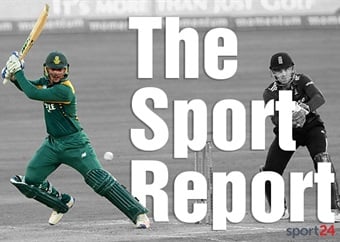Cape Town - Cricket South Africa (CSA), a non-profit organisation, has come a mighty long way ever since the beginning of the post-isolation period when they were known as the United Cricket Board of South Africa (UCBSA) under the legendary Ali Bacher. They have over the past 25 years, implemented great methods, platforms, structures and strategies for the country’s cricketing success. However, they have also been criticised for a number of aspects which has in turn, helped them to work on any shortcomings and constantly improve in the pursuit of excellence. There are many aspects that the public are unaware of, especially behind the scenes, which show exactly what CSA are about, what they stand for, where they have come from and where they are going, all linking up to a master blueprint for success.
CSA have always had the ultimate vision of making cricket a truly national sport of winners. They have aimed to ensure that cricket is supported by the majority of citizens and available to all who wish to play it. They have a mission to inculcate fairness and non-discrimination. Yes transformation is a contentious issue but the organisation views diversity as a strength and are constantly looking for the best ways to implement this. Active marketing of cricket is also another important mission among many others. Values that CSA try their best to uphold and live by include: honesty, integrity, professionalism, diligence, mutual respect and fairness.
So, where is the next Dale Steyn or Hashim Amla going to come from? CSA have some truly great platforms and programmes currently in place for the development of the game as a whole, from the lowest possible level all the way to the national team. Cricket HUBS and regional performance centres (RPCs), are effective cricketing centres put in place by the federation with the aim to develop players from grassroots level right through to senior cricket. The main objective of a HUB is increased and sustained participation, community engagement, bursary opportunities, developing and identifying talent and much more. Initiatives such as these can only benefit the game.
CSA have also built up a fantastic player pipeline system. The most junior level is the ever dependable KFC Mini-Cricket project where the aim is to ‘attract, retain and develop’ as players go up the ladder onto schools cricket, followed by the talent acceleration programme and then through to the SA under 19s. This is where things start to get serious and a player is then put through to provincial systems, regional academies, club cricket and tertiary cricket. The key here is how CSA now begin preparing semi-professional players for professional cricket. This is where the national academy and emerging team programmes come into play. The system is so intricate that it is full proof. Players then move on to franchise cricket where one gets to play for the likes of the Titans, Dolphins etc. and the penultimate step is the SA ‘A’ team where it is time to prepare cricketers for international competition. The highest level obviously being our beloved Proteas. Preparing cricketers to transition out of the game is also a key CSA goal.
If this wasn’t exciting enough then there is also a coach education pathway that runs all the way from KFC Mini-Cricket to the orientation courses, level 1 (basic skills), 2 (intermediate skills), 3 (senior skills) and ultimately level 4 (national certificate).
So, where is the next Cyril Mitchley going to come from? Well, there is also a match officials (umpire) pathway where the key here is also to attract, retain, develop, create opportunities and pursue excellence. This programme runs from league and school umpires to tournament, elite tournament, CSA amateur umpire panel, CSA first class panel, CSA international panel and then all the way to the coveted ICC elite panel.
Such systems and structures can only bear fruit for all concerned.
CSA’s story also includes the formulation of strategic focus areas which revolve around ‘Silver Bullets’. This includes producing quality players to become match winners for the Proteas (anyone heard of Dale Steyn by any chance?), pipeline player performance plans and more.
The body is also governed by five strategic pillars and continually measure their progress against these: excellence, development, sustainability, transformation and brand promotion. CSA pride themselves on a sound business model with various inputs and desired outputs.
CSA are also made up of a number of impressive and indeed accountable members. They have esteemed President Chris Nenzani and his expert board of directors as well as Chief Executive Officer (CEO) and respected Mr Haroon Lorgat, a former head of the International Cricket Council (ICC) and his executive management team. Each and every member plays a pivotal role in the overall structure of CSA and their mantra is to “make success a habit”.
What about the ‘moola’ side of things in this story you may ask? Well, CSA have enjoyed some fantastic financial sustainability and highlights include an impressive financial turnaround in excess of R200 million, stadium attendances up by 20%, sponsorship revenues up by 15% and an increase in foreign investment. Improvements include creation of their own digital content and member funding being up by roughly 34%. Looking ahead, CSA are exploring opportunities to generate revenue from digital content, growing the official Proteas supporters club, improved stadium experience and much more.
There have also been highlights with regards to talent retention and development. These include the launch of the Varsity Cup and regional provincial academies. Improvements have come in the form of affiliate scorecards and incentive funding to members that achieve development targets. CSA are also looking to implement the provincial academy system across all members.
CSA have also made some strong headway in the form of transformation, which will be touched on more, a little later in the piece. There has been an increase of up to 25% in the number of black African players in the Momentum One Day Cup, diversity management and more! Also, the entire women’s squad are now contracted on a full-time basis and the body are also looking at the development of gender advocacy programmes at all levels as well as quarterly reports on team representation at all levels.
Headway has also been made in terms of brand and reputation. There is now restored confidence in CSA in general, a new partnership for official apparel and footwear in place, a successful #ProteaFire campaign (including “Fireball” song), that has got us all excited and the launch of CSA’s digital magazine. Future goals include focus on the Africa T20 competition and engaging with television to promote CSA messaging, as has been done with radio successfully. Social media initiatives have also been as successful as ever. Follow CSA on Twitter and Facebook now!
As a non-profit company, CSA is also subject to corporate governance, disclosure and other legal requirements. They are also in line with best practice and fairness and have a whistle-blowing policy via a fraud hotline.
Yes controversies are part and parcel of any federation or body in any field and cricket in South Africa is no different. Nothing is going to run smoothly forever and in certain instances there is a need for intervention and damage control. CSA aims to be transparent on all such issues.
In terms of match-fixing, CSA have always been committed to rooting out this evil aspect of the sport and have always had systems in place to prevent and/or fish out any culprit (note the whistle blowing policy mentioned earlier). Match-fixing is viewed as the ultimate sin in the sport and anyone found guilty will be dealt with accordingly. This was proved lately with the banning of four prominent players and shows that nobody is immune to the wrath of the federation.
"Whilst there has been no evidence to suggest that an actual fix in any match was carried out, these players all participated in material discussions about match fixing," said CSA chief executive Haroon Lorgat. This alone proves that even a hint of fixing will be enough for action to be taken. Tony Irish of the South African Cricketers’ Association (SACA) said "The positive is that our system has detected them and there has been a successful prosecution as a result of clean players coming forward.” The bans came more than six months after Gulam Bodi, another former international player, was banned for 20 years after admitting to charges of ‘contriving or attempting to fix matches’ in SA’s domestic Twenty20 competition.
Where is the next Makhaya Ntini going to come from you may ask? CSA as a body have always tackled the transformation issue in the best way that they could. Transformation is in essence, part of CSA’s DNA. It is also a phenomenon that is never going to please everyone. CSA tries to do the best it can, given the circumstances. CSA views diversity as a positive and try their best to provide opportunities for all South Africans, whatever their race, background or gender. In liaison with government, they have implemented certain necessary targets for our teams but with no compromise on quality and standards. Their ultimate aim is the constant and consistent excellence of the national team and will do whatever they can to ensure this while also taking care of vital transformation that is necessary for the sport to grow, thrive and indeed be accepted by the masses. Transformation across all spheres of the sport is a positive and can only benefit the country in the end, hence the new targets implemented for the national team. The South African Sports Confederation and Olympic Committee (SASCOC), remain a key stakeholder and in partnership, the two bodies aim to take transformation into the future and beyond.
As you can see form the above variables, roadmap and overall blueprint, cricket in South Africa is in decent hands. The Proteas are bound for even more glory and hopefully some ICC silverware in the near future too. Yes there is still some work to be done and a bit of tinkering here and there but overall, CSA have done more than enough to appease the cricketing mad public. These various stages of development are the pillars on which Cricket South Africa’s vision is based to become a truly national sport that is available to all who want to play it.
Other highlights of the CSA story include being acclaimed as the best sports rights holder in the country, a great financial turnaround, an enhanced reputation amongst stakeholders, increased stadium attendances and TV viewers, Protea player rankings, Protea Women excelling beyond expectations, the free to air deal with the SABC, new broadcast deal with Supersport International and new commercial deals with global brands. Another excellent initiative is the CSA Heritage Blazer which CSA have implemented as part of its transformation and history plans. This is inherently a legacy programme to honour and recognise former players from all of the previously segregated cricket federations that existed in the 100 years before cricket unity in July 1991.
Challenges going forward include transformation, diversifying revenue sources, maintaining good governance across the board, improving the profile of provincial cricket as well as the health of franchise cricket. CSA have also stressed a few vital but key critical success factors: world leading Proteas cricket teams, communication, teamwork, sustainable and mutually beneficial partnerships, personal leadership and monitoring progress towards achieving the cricket services mission.
It seems that CSA are ahead when compared to other sporting
organisations in the country and are doing their very best to ensure the
Proteas are the best on the planet. Yes there have been some setbacks but these
are outweighed by all the positives stated above. An important season looms and
CSA has no doubt that they are indeed heading in the right direction. This all
coincides with CSA’s 25 year anniversary celebrations and the body appreciates
all fans for their ongoing support and promise to
continue doing what is best for cricket in the country.




 Publications
Publications
 Partners
Partners












